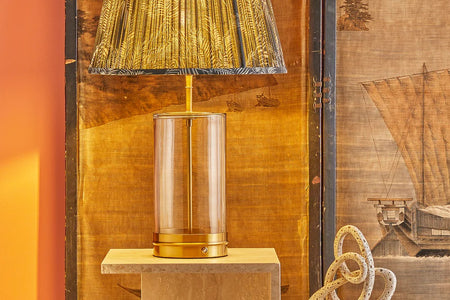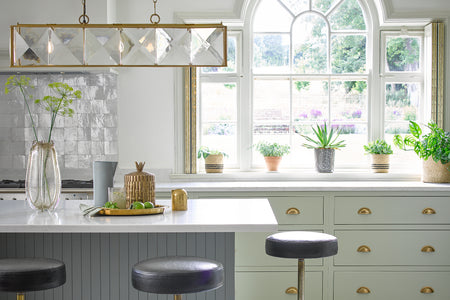
Open plan living space? The right lighting can really make it sing... Whether a kitchen-diner or a completely open plan arrangement, find out how to light it up with our expert lighting tips…
1) Use lighting to create different zones
One of the challenges of lighting a large, open space is how to make it work from a practical point of view, while also making the space feel homely and inviting. A well thought out lighting scheme can help you strike the right balance between function and atmosphere.
Lighting is classified into three main types: ambient lighting, which is the overall amount of light available in a room; task lighting, which is targeted lighting for carrying out specific tasks; and accent lighting, which is used for highlighting certain features and adding atmosphere.
Even in an open plan space, each area within that space will have its own specific lighting needs. As a starting point, look to identify those areas that require stronger, practical lighting, and those that will benefit from some lower-level mood lighting.
For example, the kitchen area will need to include plenty of task lighting for cooking and preparing food, while the dining and living areas will benefit from some softer, more intimate lighting options for relaxing and entertaining.
By using your lighting scheme to create different zones within your open plan space, and by combining different types of lighting - known as ‘layering’ lighting - you can ensure that you have enough practical light where you need it, while also creating the perfect ambience.

Kitchen-diner by Alex Gardner, Interior Designed. Image: Woodstock Furniture
2) Create a focal point with pendant lights
Pendant lights are a great choice in an open plan space, where walls and other fixing points can be in short supply…. They come in a vast range of different styles and materials, and will provide plenty of good ambient and task lighting, while also creating an eye-catching focal point.
In an open plan kitchen area, a striking designer pendant light suspended from the ceiling will help to lift the eye upwards, while making a proper style statement. You can supplement the light from your pendant by placing spotlights, recessed lighting and undercabinet lights in the main cooking and preparation areas, such as the sink, cooker and worktops.
If you have a kitchen island, suspend a set of pendant lights overhead. Depending on the size of the island, groups of three or five pendants work particularly well.
Meanwhile, a large decorative pendant suspended over the dining table will help to delineate the dining area as a zone in its own right.
And finally in the living area, a beautiful pendant light - ideally on a dimmer – will provide atmospheric ambient lighting while also highlighting and defining the space. For some serious wow factor, why not go all out with a gorgeous chandelier.

Open plan living space, divided by pendant lighrs. By Claire Botha of Geek Vintique
3) Add some atmosphere with lamps and wall lights
While pendant lights provide great overhead lighting, you can bring in other layers of lighting to create a more cosy, relaxing vibe within your open plan space.
Downlighters can help to create a more intimate feeling within a larger space. For example, a set of wall lights in the dining area, or on either side of the sofa in the living area, will create an ambient glow and will help to frame the space.
Meanwhile, some decorative table lamps set strategically around the living area will offer warm, lower-level light.
Add in a stylish floor lamp or two to create the perfect mood for relaxing with friends after dinner. Or for some solo chill-out time, make a cosy nook in the living area by suspending a stylish reading floor lamp above a favourite chair.
Finally, installing some dimmer switches within the different zones will offer extra flexibility, allowing you to set the right mood for different activities and at different times of day.

Open plan living space by Lauren Gilberthorpe
4) Highlight key features with accent lighting
Accent lighting can help to add depth and interest within an open plan space, by drawing attention to a particular area or emphasising a specific set of features.
Think about which areas within the space you would like to highlight. This might be a favourite piece of artwork, some beautiful natural beams or perhaps a quirky architectural feature.
Picture lights are designed for showcasing artwork, while table lamps will add depth and warmth to an alcove or corner.
Floor lamps are another very effective way of accentuating an area or feature within an open plan space; indeed, some floor lamps are like works of art in their own right! In the living area, a pair of traditional matching floor lamps will frame a period fireplace beautifully. Or for some drama in the dining area, suspend a striking standalone floor lamp over the dining table, to add that extra bit of character and interest.
Finally, to add to the overall ambience, place some accent lighting underneath shelves or inside glass cupboards or cabinets.

Interior design by Tash South. Photo: Michele Beatty
5) Use lighting to bring the space together
As well as helping to define the different zones within your open plan space, your lighting scheme can also help to unify the area as a whole. That stops your open plan space feeling too chaotic or mish-mashy (unless you like that sort of thing, of course!).
So when choosing your light fittings you can consider the existing style and decor. Think about fittings that complement the overall feel of the space, whether you have an uber-modern city pad or a traditional country cottage.
Another way to provide unity is to use your lighting to create a consistent theme that runs throughout - perhaps by using lampshades with colour accents, or using similar styles of lighting across the space.
Pooky makes beautiful, afforable designer lighting for beautiful rooms. Browse our range of lamps, shades and more here.
See also:
The Secrets of Lighting - 5 inspirational insights from the interior design experts
How to use lighting to make a room look bigger
Picture top: Barbara Ramani










